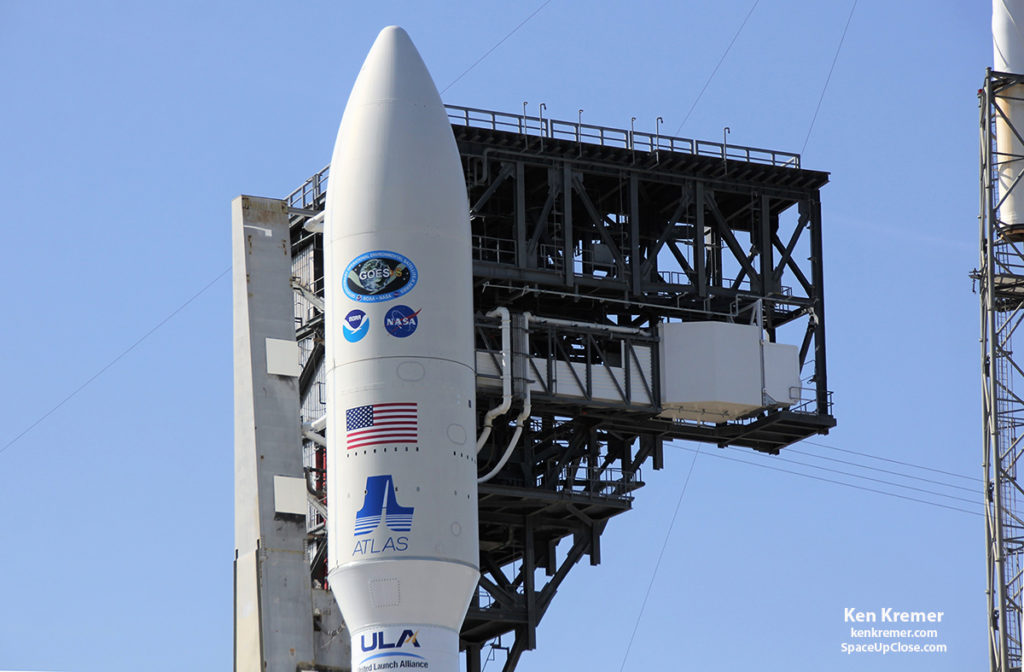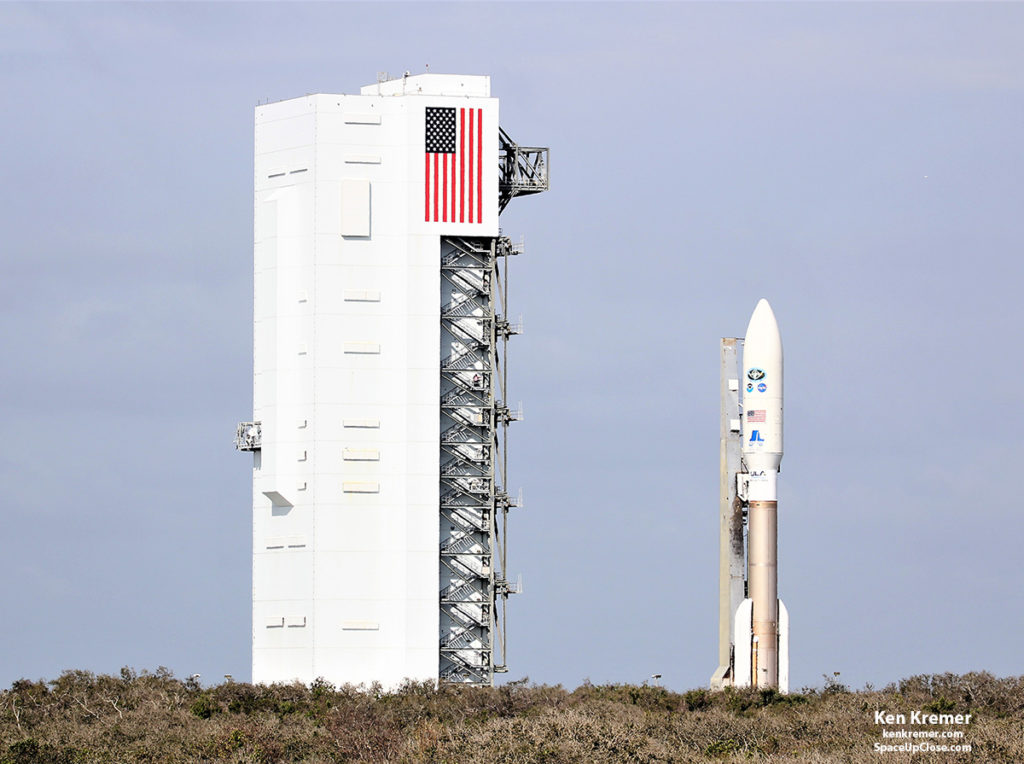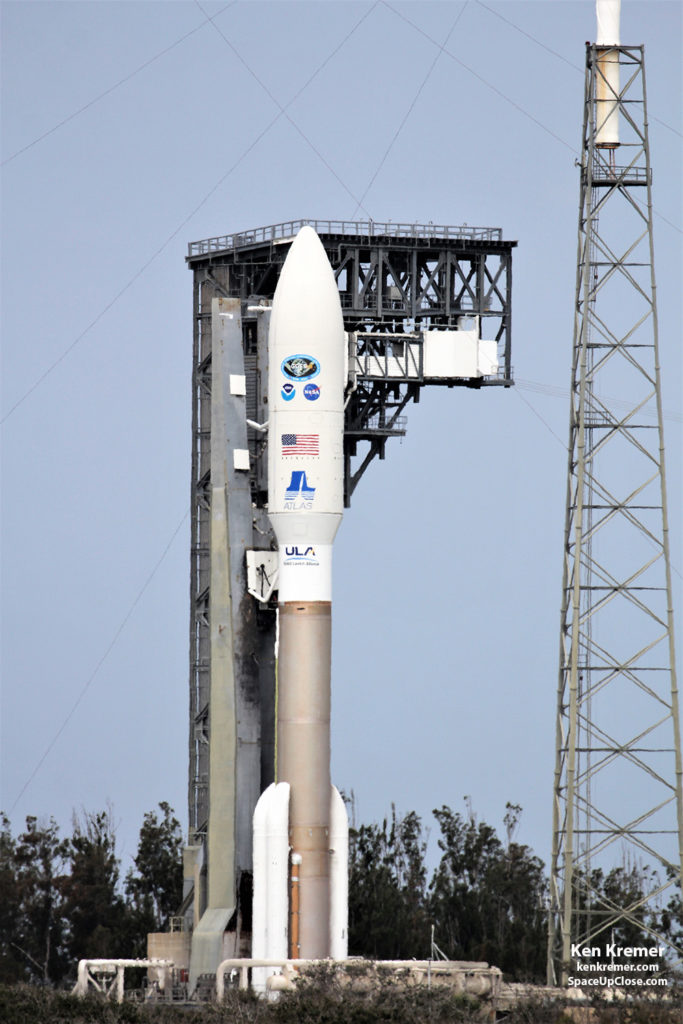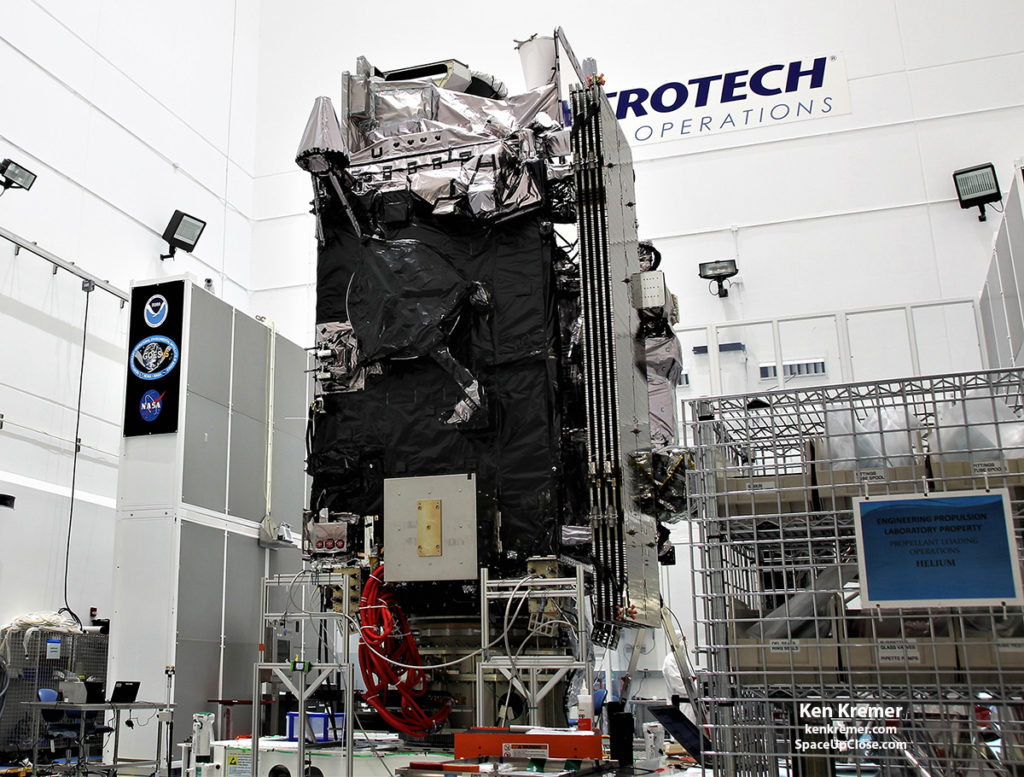CENTER, FL – At T minus 1 day, all systems are GO for the March 1 dinnertime liftoff
of the NOAA/NASA GOES-S geostationary weather observation satellite that will be
carried to orbit on a ULA Atlas V rocket from the Florida Space Coast and deliver
a quantum leap in weather forecasting for the western United States.
Atlas V and we are go for liftoff,” Tim
Gasparrini, GOES-S program manager for Lockheed Martin, told Space Up
Close during an interview today, Feb. 28, at the KSC press site a day before launch.
Lockheed Martin Space Systems,
Littleton, Colorado.
passed the Launch Readiness Review (LRR) said mission managers from the launch
team comprising NASA, NOAA, ULA, Lockheed Martin and the 45th Space
Wing.
geostationary weather observation satellite is scheduled for Thursday, March 1, 2018, near sunset at 5:02 p.m. EST aboard a United Launch Alliance
(ULA) Atlas V rocket from seaside Space Launch Complex-41 on Cape Canaveral Air
Force Station in Florida.
hours from 5:02 – 7:02 p.m. EST.
It will be
delivered to geostationary orbit soaring some 22,200 mi (35800 km) above Earth. You can watch the launch via a live
broadcast on NASA TV beginning at 4:30
p.m. March 1 with additional commentary on the NASA launch blog.
watch the launch live at NASA TV at: http://www.nasa.gov/nasatv
Thursday’s launch weather outlook is rather promising for this next generation
weather satellite years in the making.
forecast shows a 80 percent chance of favorable weather conditions for
Thursday’s near sunset blastoff at launch time, said U.S. Air Force Air Force Meteorologist Kathy Winters with the 45th
Space Wing Weather Squadron on Patrick Air Force Base.
Clouds and Ground Winds.
technical or weather the backup launch opportunity is Friday, March 2 at 5:02
p.m.
favorable. The primary concern is Cumulous Clouds.
liftoff should be spectacular! – Since its targeted for shortly before sunset which
is often prime time for witnessing the best and most beautiful skywatching for launches
that the space coast has to offer.
Geostationary Operational Environmental Satellite–S, is a new and advanced
transformational weather satellite that will vastly enhance the quality, speed
and accuracy of weather forecasting available to forecasters for Earth’s
Western Hemisphere after it becomes operational later this year.
orbit GOES-S will be renamed as GOES-17/GOES West.
orbit and the GOES-17 launch will do that as the second new GOES spacecraft in
orbit,” FL, Tim
Walsh, acting GOES-R system program director at NOAA told
Space UpClose during a recent interview with reporters in the cleanroom with
the spacecraft at Astrotech
Space Operations in Titusville, Fl, where technicians were actively processing
the probe to ready it ahead of this week’s thunderous launch.
 |
|
Up close view of nose cone housing NASA/NOAA GOES-S
weather satellite atop ULA Atlas V rocket on Feb. 28, 2018. Credit: Ken Kremer/SpaceUpClose.com/kenkremer.com |
sister observatory to GOES-R, which launched late in 2016 and recently became
operational – and was renamed the GOES-16/GOES East satellite for the eastern
US at its geostationary orbit soaring some 22,200 mi (35800 km) above Earth.
stated. “It will give us the equivalent perspective for the western US that we
now have for the eastern US using the six onboard instruments namely ABI and
GLM, SUVI, EXIS, SEIS and the magnetometer.”
GOES-R series of America’s most powerful and most advanced next generation geostationary weather observation
satellites. It is designed to last for a
15 year orbital lifetime and will deliver a ‘quantum leap’ in weather
forecasting.
science suite includes the Advanced Baseline Imager (ABI), Geostationary Lightning Mapper (GLM),
Solar Ultraviolet Imager (SUVI), Extreme Ultraviolet and X-Ray Irradiance
Sensors (EXIS), Space Environment In-Situ Suite (SEISS), and the Magnetometer
(MAG).
ABI is the primary instrument and will collect 3 times more spectral data with 4 times greater
resolution and scans 5 times faster than ever before – via the primary Advanced
Baseline Imager (ABI) instrument – compared to the current GOES satellites.
12.8 ft) with a three-axis
stabilized spacecraft bus.
(11,446 lbs) at launch.
V in the very powerful 541 configuration, augmented by four solid rocket
boosters on the first stage. The payload
fairing is 5 meters (16.4 feet) in diameter and the upper stage is powered
by a single-engine Centaur.
ULA, Boeing, Lockheed Martin, Orbital ATK and more space and mission
reports direct from the Kennedy Space Center and Cape Canaveral Air Force Station,
Florida.
Earth and Planetary science and human spaceflight news: www.kenkremer.com –www.spaceupclose.com –
twitter @ken_kremer – ken
at kenkremer.com





